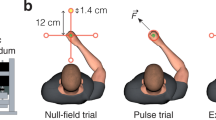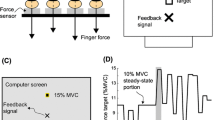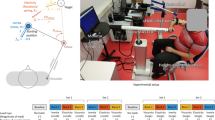Abstract
When humans are exposed to external forces while performing arm movements, they adapt by compensating for these novel forces. The basis of this learning process is thought to be a neural representation that models the relation between all forces acting upon the system and the kinematic effects they produce, called inverse dynamic model (IDM). The present study investigated whether and how the predictability of a given external force affects the selection of an appropriate motor response to compensate for such force. Adult human subjects (N=32) held a handle that could rotate around the elbow joint and learned to perform goal-directed forearm flexion movements, while an external velocity-dependent negative damping force was applied that assisted forearm movement. Subjects were randomly assigned to two groups. In the associative group, the applied damping force was always associated with a specific initial position. Thus, after initial learning, the force application became predictable. In the non-associative group, where the same movements were performed, the applied force was independent of the initial position, so that no association between force and location could be formed. We found that only the associative group significantly reduced target error when damping was present. That is, the location cue aided these subjects in generating dynamic responses in the appropriate limb. Our results indicate that motor adaptation to different dynamic environments can be facilitated by indicative stimuli.





Similar content being viewed by others
References
Conditt, M. A., Gandolfo, F., & Mussa-Ivaldi, F. A. (1997). The motor system does not learn the dynamics of the arm by rote memorization of past experience. Journal of Neurophysiology, 78, 554–560.
Gandolfo, F., Mussa-Ivaldi, F. A., & Bizzi, E. (1996). Motor learning by field approximation. Proceedings of the National Academy of Sciences USA, 93, 3843–3846.
Jordan, M. I., & Rumelhart, D. E. (1992). Forward models: Supervised learning with a distal teacher. Cognitive Sciences, 16, 307–354.
Kalveram, K. T. (1991). Pattern generating and reflex-like processes controlling aiming movements in the presence of inertia, damping and gravity. Biological Cybernetics, 64, 413–419.
Kalveram, K. T. (1998). Wie das Individuum mit seiner Umwelt interagiert. Lengerich, Germany: Papst.
Kalveram, K. T. (2000). Sensorimotor sequential learning by a neural network based on redefined Hebbian Learning. In Malmgren, H., Borga, M., & Niklasson, L. (Eds). Artificial Neural Networks in Medicine and Biology (pp. 271–276). London: Springer.
Karniel, A., & Mussa-Ivaldi, F. A. (2002). Does the motor control system use multiple models and context switching to cope with a variable environment? Experimental Brain Research, 143, 520–524.
Konczak, J., Jansen-Osmann, P., & Kalveram, K. T. (2003). The development of force adaptation during childhood. Journal of Motor Behavior, 35, 41–52.
Rao, A. K., & Shadmehr, R. (2001). Contextual cues facilitate learning of multiple models of arm dynamics. Society of Neuroscience Abstracts, 302, 4.
Shadmehr, R., & Holcomb, H. H. (1997). Neural correlates of motor memory consolidation. Science, 277, 821–825.
Shadmehr, R., & Holcomb, H. H. (1999). Inhibitory control of competing motor memories. Experimental Brain Research, 126, 235–251.
Shadmehr, R., & Mussa-Ivaldi, F. A. (1994). Adaptive representation of dynamics during learning of a motor task. Journal of Neuroscience, 14, 3208–3224.
Vetter, P., & Wolpert, D. M. (2000). Context estimation for sensorimotor control. Journal of Neurophysiology, 84, 1026–1034.
Wolpert, D. M., & Kawato, M. (1998). Multiple paired forward and inverse models for motor control. Neural Networks, 11, 1317–1329.
Wolpert, D. M., Ghahramani, Z., & Jordan, M. I. (1995). An internal model for sensorimotor integration. Science, 269, 1880–1882.
Author information
Authors and Affiliations
Corresponding author
Rights and permissions
About this article
Cite this article
Richter, S., Jansen-Osmann, P., Konczak, J. et al. Motor adaptation to different dynamic environments is facilitated by indicative context stimuli. Psychological Research 68, 245–251 (2004). https://doi.org/10.1007/s00426-003-0140-y
Received:
Accepted:
Published:
Issue Date:
DOI: https://doi.org/10.1007/s00426-003-0140-y




